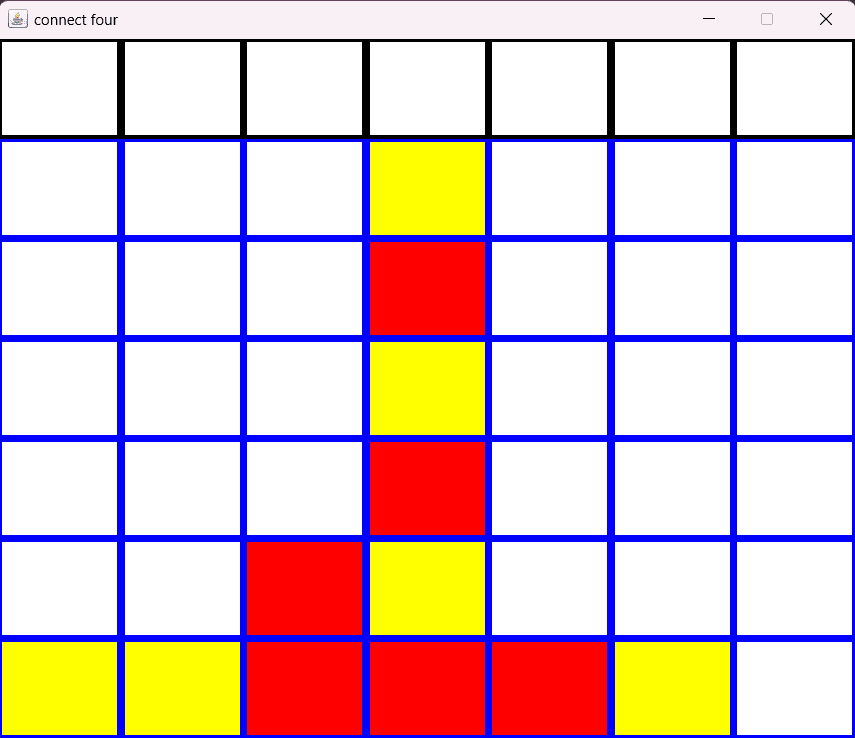Connect Four marked my first serious step beyond trivial game trees into the world of combinatorial explosion. After Tic-Tac-Toe introduced me to the mechanics of adversarial search, Connect Four forced me to grapple with deeper search spaces, pruning strategies, and board representation. It became the bridge between simple deterministic environments and the more sophisticated projects that followed, such as Gomoku and BitSnake, where complexity and uncertainty reached new heights.
Why Connect Four?
I wanted to tackle a game that couldn’t be solved by brute force alone. Tic-Tac-Toe’s full game tree could be exhaustively searched, but Connect Four was different: the branching factor quickly exceeded naive approaches and forced me into the realm of efficiency. For the first time, I had to face the reality that not every path could be explored, and decisions about which parts of the tree deserved attention became central to the design. This challenge made Connect Four more than just another game—it became an initiation into the real mechanics of algorithmic optimization.
Cracking Bigger Trees
-
Search Algorithms:
- I implemented Minimax with Alpha-Beta pruning, an algorithm that slashes away irrelevant branches and allows deeper lookahead within the same computational budget.
- To further optimize, I experimented with transposition tables—caches of already-seen positions that prevent redundant work—and bitboards, compact binary encodings of the board that speed up evaluation.
-
Search Depth:
- Typical searches reached 8–10 plies (half-moves), but with pruning and caching, these limits could be pushed further without blowing up computation.
- Compared to Tic-Tac-Toe’s trivial tree, the difference was night and day. Here, every extra ply gained through optimization had a visible impact on the agent’s strategic foresight.
-
Evaluation Heuristics:
- Simple pattern counts: two-in-a-row, three-in-a-row, and potential fours.
- A heavy emphasis on the center column, reflecting real-world strategy guides that stress the value of occupying central ground.
- Immediate win/loss detection, ensuring the AI never overlooked a tactical knockout.
- Layered scoring that weighted threats differently depending on their urgency (e.g., an open three outranked a closed four).
-
GUI Framework:
- I built a Java Swing interface so that I could play directly against the agent. This was my first foray into making AI interactive rather than hidden behind a console, and it made testing far more engaging.
What I Saw in Practice
The AI developed strong habits. It consistently dominated the center, a reflection of both heuristic weighting and genuine strategic strength. It also became surprisingly adept at setting up “trap” moves—positions where any response by the opponent led inevitably to defeat two or three turns later. Playing against it taught me to see Connect Four differently: not just as a casual puzzle, but as a layered tactical landscape with echoes of chess-like planning. These emergent strategies weren’t programmed explicitly; they arose as a natural consequence of search depth combined with smart evaluation.
Imagining Extensions
- Monte Carlo Tree Search: Could add a probabilistic angle, letting the agent sample moves at random to estimate value without deep deterministic search.
- Reinforcement Learning: Through self-play, the agent could refine its heuristics, developing a sense of priority that surpasses handcrafted rules.
- Parallelization: Using multi-threading to evaluate multiple branches at once, pushing depth far beyond the limits of a single CPU thread.
- Human-Like Play: By deliberately limiting depth or introducing randomness, the agent could simulate weaker levels of play, making it a more interesting sparring partner.
How It Shaped My Thinking
Connect Four was the moment adversarial search “clicked.” Concepts that were abstract in Tic-Tac-Toe—like branching factor, heuristic scoring, and pruning—suddenly became concrete. I learned that the real challenge isn’t just writing an algorithm, but taming the explosion of possibilities into something manageable. These lessons flowed directly into Gomoku, where the search tree exploded even further, and BitSnake, where simultaneous moves introduced timing and uncertainty. Without the lessons of Connect Four, I would have been far less prepared to handle those projects. It was here that I realized the craft of AI is not brute force but selective vision.
